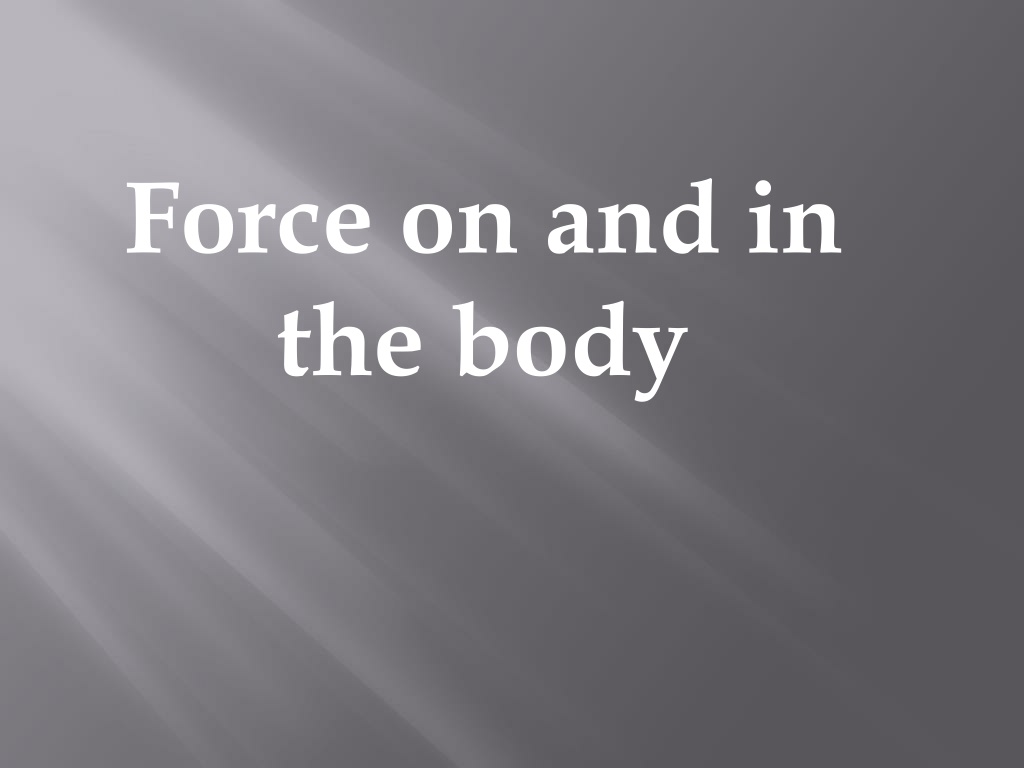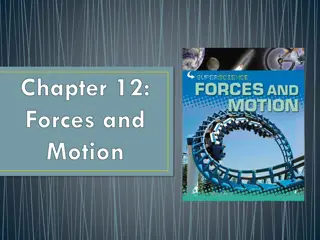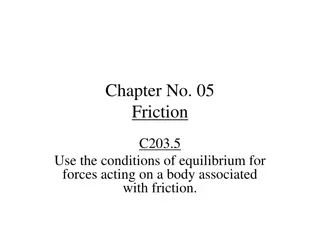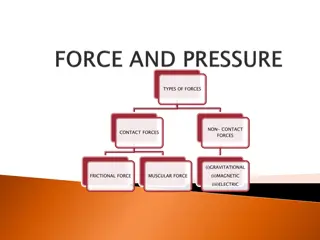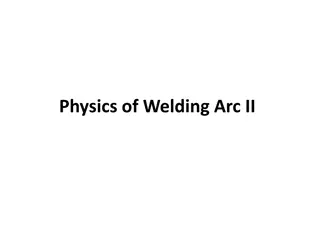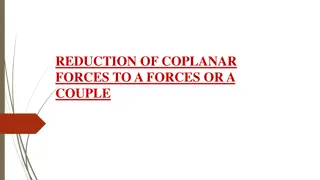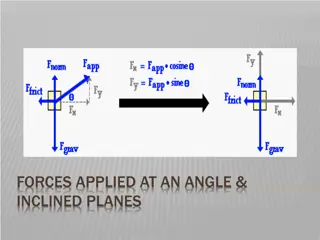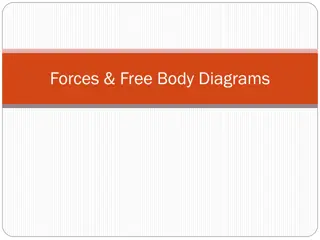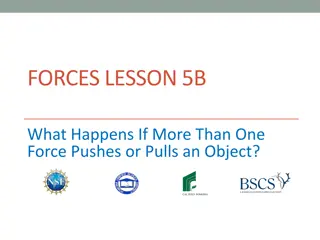Understanding Forces on and in the Human Body
Newton's law of universal gravitation explains the gravitational force that affects our weight and other bodily functions. Electrical forces play a crucial role in muscle control and cell functions, while nuclear forces keep protons together in the nucleus. These forces have significant impacts on our health and body functions, highlighting the complex interactions within our bodies.
Download Presentation

Please find below an Image/Link to download the presentation.
The content on the website is provided AS IS for your information and personal use only. It may not be sold, licensed, or shared on other websites without obtaining consent from the author. Download presentation by click this link. If you encounter any issues during the download, it is possible that the publisher has removed the file from their server.
E N D
Presentation Transcript
Force on and in the body
Forces Forces in the body Forces on the body 1-Gravitational force 2-Electrical force 3-Nuclear force 1- Static force 2-Dynamic force 3-Frictional force
1-Gravitational forces: Newton formulated the law of universal gravitation. This law states that there is a force of attraction between any two objects; our weight is due to the attraction between the earth and our bodies. The gravitational force is much smaller on the moon.
1-The formation of varicose veins in the legs as the venous blood travels against the force of gravity on its way to the heart. 2-Medical effects of gravitational force on the skeleton (0n the bones), in some way contributes to "healthy bones". If a person becomes "weightless" such as in an orbiting satellite, he may lose some bone mineral, and this may be a serious problem on very long space journeys. Long-term bed rest removes much of the force of the body weight from the bones and can lead to serious bone loss.
This force more complicated than gravity since it involves attractive and repulsive forces between static electrical charges as well as magnetic force produced by moving electrical charges (electrical current).Electrical forces are immense compared to gravitational force. For example, the electrical force between an electron and a proton in a hydrogen atom is about 1039times greater than the gravitational force between them. Our bodies are basically electrical machines. This forces produced by the muscles are caused by electrical charges attracting or repelling other electrical charges.
Control of the muscles is primary electrical .Each of the billions of living cells in the body has in electrical potential difference across the cell membrane because of the differences in charge between the inside and outside of the cell. This amount to less than 0.1V, but because of the very thin cell wall it may produce a field as large as 105V/cm.
Nuclear force keep the positive charges "proton" together inside the nucleus .we have two types of nuclear forces: 1-Strong nuclear force: it is very larger than the other type. it is act as "glue" to hold the nucleus against the repulsive forces that produce by the protons on each other 2-Weaker nuclear force: it is involved with electron decay from the nucleus. It may be related to the electrical force.
1-Statics : When objects are stationary (static) they are in a state of equilibrium. The sum of the forces in any direction is equal to zero, and the sum of the torques about any axis also zero. Many of the muscle and bone systems act as levers which are classified to: a-First class levers: They are least common in the body. The fulcrum point (F) is between the muscle forces (M) and the weight (W), for example the head. b-Second class levers: They are found more than first class levers. Weight (W) is between the fulcrum point (F) and muscle forces (M), for example standing on the toes. c- Third class levers: They are most common in the body. Muscle forces (M) is between fulcrum point (F) and weight (W).For example, the arm in the elbow joint.
(First class) (Second class) (Third class)
A simple example of a lever system in the body is the case of the biceps muscle and the radius bone acting to support a weight W in the hand (Figure 2a).Figure 2b show the forces and dimension of a typical arm. We can find the force supplied by the biceps if we sum the torques about the pivot point at the joint. There are only two torques: that due to the weight W, which is equal to 30W acting clockwise, and that produce by the muscle counterclockwise and of magnitude 4M.With the arm in equilibrium we find that: 4M-30W=0 Or that a muscle force 7.5 times the weight is needed (we neglected the weight of the forearm and hand).Figure 2c show a more corrects representation of the problem with weight of the forearm and hand H included. By summing the torques about the joint we obtain M= 3.5 H+7.5W force M which M=7.5W
However, the length of the biceps muscle changes with the angle. In general, each muscle has a minimum length to which it can be contracted and a maximum length to which it can be stretched and still function. At these two extremes the force the muscle can exert is essentially zero. At some point in between, the muscle can produce its maximum force (figure 4).
If the biceps pulls vertically the angle of the forearm does not affect the force required but it does affect the length of the biceps muscle, which affects the ability of the muscle to provide the needed force. The arm can be raised and held out horizontally from the shoulder by the deltoid muscle(figure5 a); we can show the forces schematically (figure5 b).By taking the sum of the torques about the shoulder joint ,the tension T can be calculate from W1(the weight of the arm),and W2(the weight in the hand). ? =??1 + ??2 ????
This force is important when the body is moving and hitting another body. It appears on the body where acceleration or deceleration is involved . The Newton's second law, force equals mass times acceleration. F=ma Newton said" force equals momentum (mv) over a short interval of time t " the change of
Example 1: A( 60 kg) person walking at( 1 m/sec )bumps into a wall and stops in a distance of( 2.5 cm )in a about( 0.05sec) .what is the force developed on impact? (mv) = (60 kg)(1m/sec) (60 kg)(0 m/sec) = 60 kg m/sec =1200 N
Example 2: a-A person walking at (1 m/sec) hits his head on a steel beam . Assume his head stops in (0.5 cm) in about 0.01 sec. If the mass of his head is (4kg), what is the force developed? (mv) = (4 kg)(1m/sec) (4 kg)(0 m/sec) = 4 kg m/sec =400 N
b- If the steel beam has (2cm) of padding and t is increased to (0.04 sec), what is the force developed? = 100 N
An example of a dynamic force in the body is the apparent increase of weight when the heart beats (systole).About 60 g of blood is given a velocity of about 1 m/sec upward in about 0.1 sec. The upward momentum given to the mass of blood is (0.06kg) (1m/sec) or 0.06kgm/sec; thus the downward reaction force (Newton's third law) produced on the rest of the body is (0.06 kg m/sec)/0.1 sec or 0.6 N. This is enough to produce a noticeable jiggle on a sensitive spring-type scale.
If a person jumps from a height of 1m and lands stiff-legged, he is in for a shock. Under these conditions, the deceleration of the body takes place mostly through compression of the padding of the feet .The body is traveling at 4.5 m/sec just prior to hitting, and if the padding collapses by 1cm the body stops in about 0.005 sec. The force in the legs is almost 100 times the person's weight .If this person landed on a gym mat the deceleration time would be longer, and if he followed the normal body reaction he would land toes first and bend his knees to decelerate over a much longer time, thus decreasing the landing force.
Because of the large velocity of modern cars the riders have a large momentum than when walking. In an accident the car often stops in a short time, producing very large forces. The results of these large forces on the passengers can be broken bones, internal injuries, and sometimes death. Consider the case of "whiplash" A person sitting in an auto that is struck from behind will often suffer a whiplash injury of the neck (cervical region of the spine).When the car is struck, forces act through the seat forcing the truck of the body ahead (figure 6a), while the inertia of the head causes it to stay in place, leading to severe stretching of the neck (figure 6b). In milliseconds the head is forced to accelerate forward (figure 6c).
Accelerations can produce a number of effects as:- 1-An apparent increase or decrease in the body weight . 2-Changes in the internal hydrostatic pressure. 3-Distortion of the elastic tissues of the body. 4-The tendency of solids,with different densities suspended in a liquid, to separate. 5-If the acceleration becomes large ,the body will lose control because it does not have the adequate muscle force to work against the large acceleration force. 6-Under certain condition, the blood may pool in various regions of the body; the location of pooling depends upon the direction of acceleration. If a person is accelerated head first the lack of blood flow to the brain can cause blackout and unconsciousness. 7-Astronauts in an orbiting satellite are in a condition of " weightlessness " some physiological changes take place. 8-Tissue can be distorted by acceleration, and if the forces are very large, tearing or rupture can take place.
Sedimentation The tendency of suspended solids of different densities to separate when accelerated is not important in the body but it is utilized in the common laboratory centrifuge. The centrifuge is a way to increase apparent weight. It is especially useful for separating a suspension in a liquid. It speeds up the sedimentation that occurs at a slow rate under the force of gravity. When we drop pebbles into a pond they fall to the bottom at a constant speed much slower than their speed in air. Grains of sand fall through water at a still slower speed. Very fine particles (silt) appear to remain suspended. The speed at which small objects fall through a liquid depends on their size, the viscosity of the liquid, and the acceleration due to gravity g.
We can artificially increase g by spinning the fluid in a centrifuge. This will cause very fine particles to separate from the fluid. Let us consider first sedimentation of small spherical objects of density p in a solution of density p in a gravitational field g . We know that falling objects reach a maximum (terminal) velocity due to viscosity effects. Stoke has shown that for a spherical object of a radius a , The retarding force Fdand terminal velocity v are related by Fd
Where is the viscosity of the liquid through which the sphere is passing .The SI unit for viscosity is the Pascal second (Pas), The unit for viscosity is the poise (1Pas= 10 poise). cgs When the particle is moving at a constant speed, the retarding force is in equilibrium with the difference between gravitational force and the upward buoyant force (the weight of the liquid the particle displaces). Thus we have: the downward
The force of the gravity The buoyant force The retarding force Fd Fgacts downward and FB difference is equal to Fd Fg= 4/3 a3p g FB= 4/3 a3p g acts upward,and the Fd=Fg-FB We obtain the expression for the terminal velocity (sedimentation velocity),
In some forms of disease such as rheumatic fever, rheumatic heart disease, and gout, the red blood cells clump together and the effective radius increases; thus an increased sedimentation velocity occurs. In other diseases such as hemolytic jaundice and sickle cell anemia, the red blood cells change shape or break. The radius decrease; thus the rate of sedimentation of these cells is slower than normal. Hematocrit is the percent of red blood cells in the blood. Since the sedimentation velocity is proportional to the gravitational acceleration, it can be greatly enhanced if the acceleration is increased. We can increase g means of a centrifuge, which provides an effective acceleration geff by geff=42 f2 r
Where f is the rotation rate in revolution per second and r is the position on the radius of the centrifuge where the solution is located. Hematocrit depends upon: 1-Radius of centrifuge. 2-Speed of centrifuge. 3-Duration of centrifuge
Frictional and the energy loss due to friction appear everywhere in our everyday life. Friction limits the efficiency of most machines such as automobiles. On the other hand, we make use of friction in devices such as rubber tires and automobiles brakes. In the body, friction effects are often important. When a person is walking, as the heel of the foot touches the ground a force is transmit from the foot to the ground (figure 7a ). We can resolve this force into components. The vertical reaction force is supplied by the surface and is labeled N (a normal force). electrical generators and horizontal and vertical
The horizontal reaction component must be supplied by frictional force. The maximum force of friction is usually describe by Where N is a normal force and is a coefficient of friction between the two surfaces. The value of depends upon the two material in contact, and it is essentially independent of the surface area.
Measurements have been made of the horizontal force component of the heel as it strikes the ground when a person walking ( figure 7a ), and it has been found to be approximately 0.15W,where W is the person's weight. This is how large the frictional force must be in order to prevent the heel from slipping. If we let N=W then we can apply a friction a force as large as . In general, the frictional force is large enough both when the heel touches down and when the toe leaves the surface (figure 7b ) to prevent a person from slipping. Occasionally person is on an icy, wet, or oily surface where is less than 0.15 and his foot slips. This in not only embarrassing; it may result in broken bones.
Friction must be overcome when joints move, but for normal joints it is very small. The coefficient of friction in bone joints is usually much lower than in engineering-type material. If a disease of the joint exists, the friction may become large. The synovial fluid in the joint is involved in the lubrication. The saliva act as lubricant, Most of the large organs in the body are in more or less constant motion .Each time the heart beat its moves, the lungs move inside the chest with each breath, and the intestines have a (peristalsis) as they move food toward its final destination. All of these organs are lubricated by slippery mucus covering to minimize friction. slow rhythmic motion
